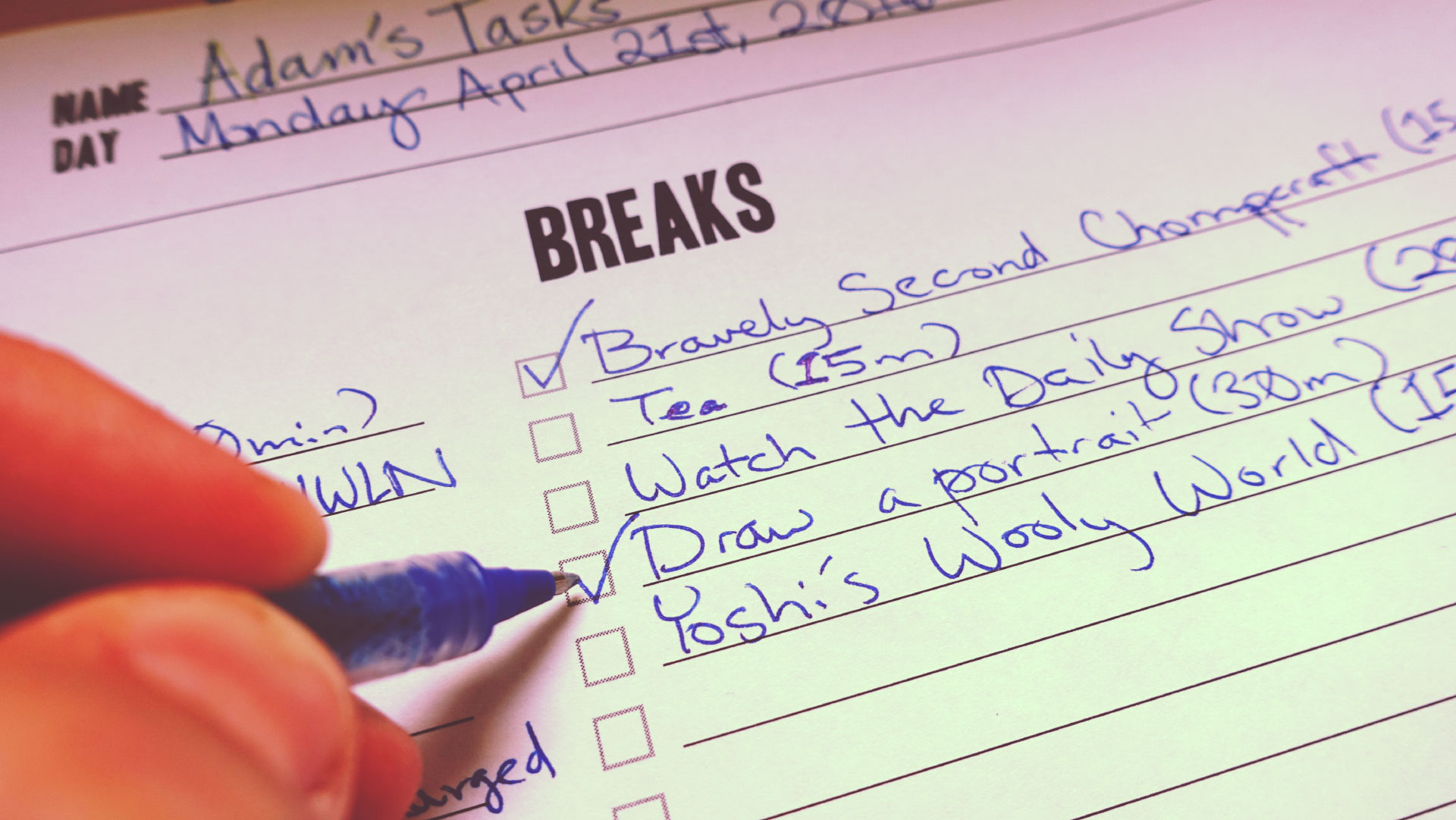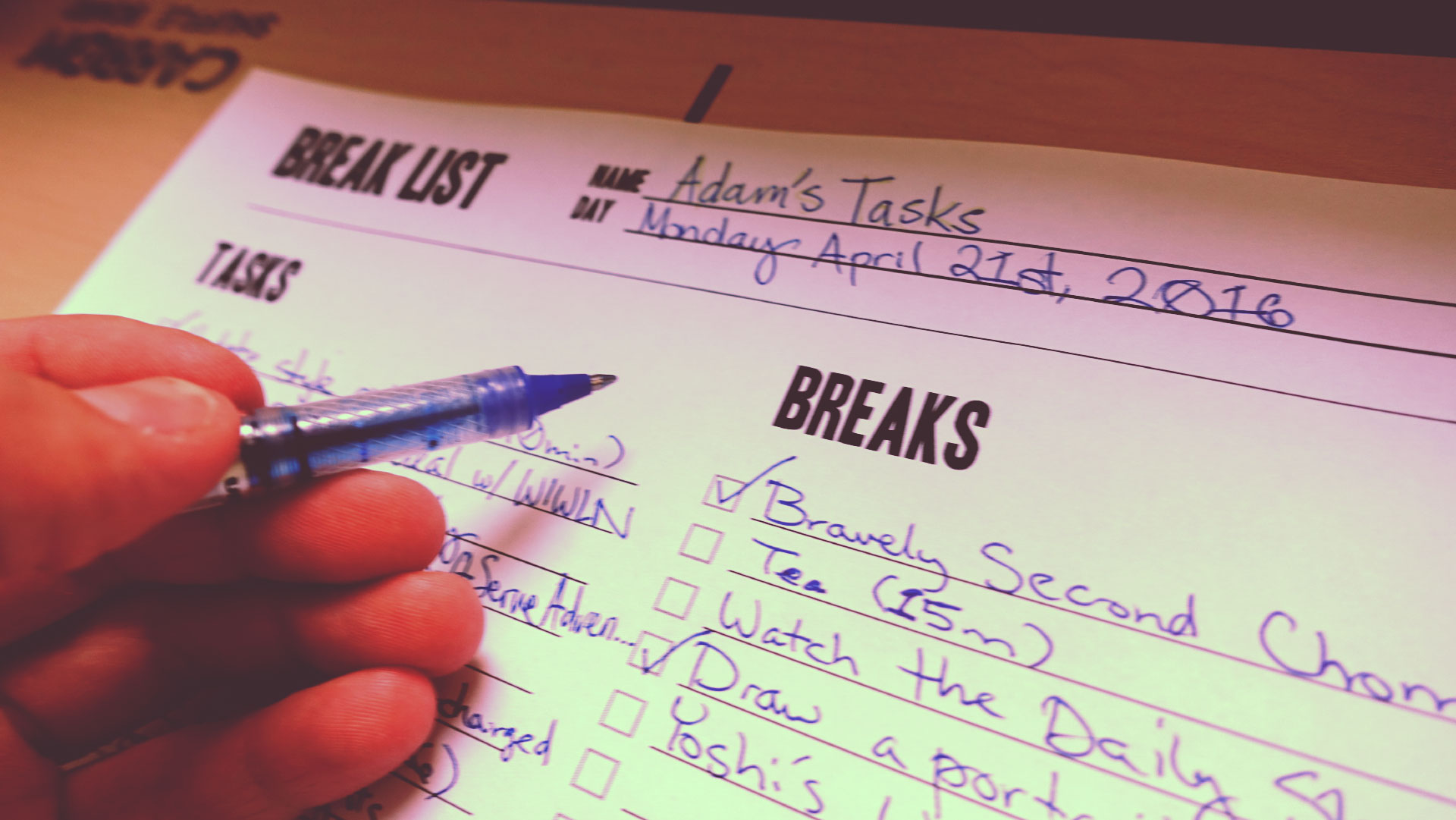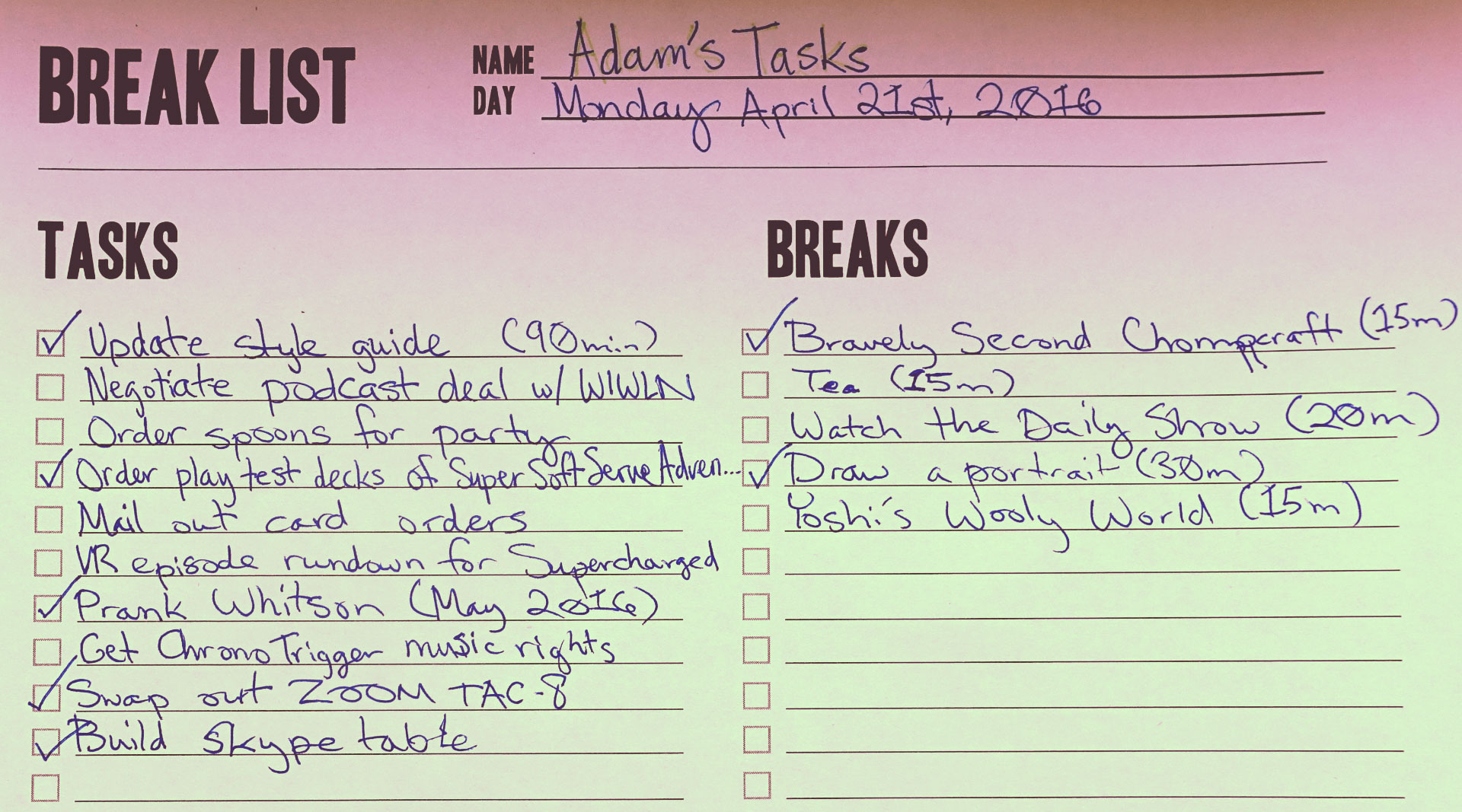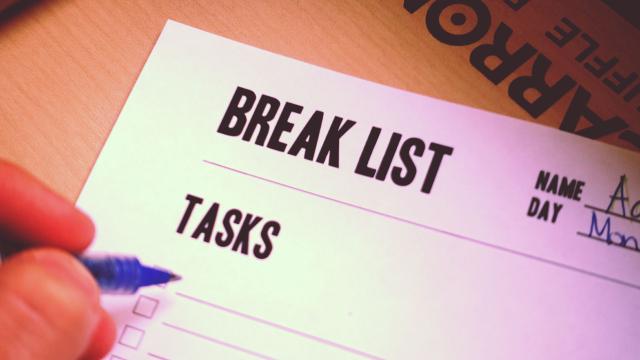To-do lists keep track of tasks we have to do, but they hardly ever provide actual motivation. A small tweak to your productivity method can solve that problem pretty quickly. All you need to do is start maintaining a “break list” instead, and you’ll find yourself more eager to get things done.
What’s a Break List?

To-do lists, task lists or whatever you want to call them, all feel one way to me: overwhelming. I throw stuff on there I don’t want to forget, and no matter how much time I spend (or waste?) organising those lists, they just look like an insurmountable pile of work. Some days I can live with that burden and breeze through the top priorities. Other days — generally the bad ones — I struggle to see any end to the work. After all, by nature to-do lists never end. They go on forever until you die and they don’t care about giving you a break. I thought, what if the lists did care about taking breaks?
Breaks are good. You need them to avoid burnout and keep your sanity. Breaks can turn into elongated procrastination sessions, too, and if you don’t manage them you’ll spend a lot of time fooling around that you should have spent getting things done. If taking functional breaks can help and dysfunctional breaks can hurt, you probably ought to manage them, right? To-dos get forgotten or out of hand when they’re not managed, so if you have a to-do list you ought to also have a break list.
Here’s the short definition of a break list: A set of planned breaks with planned times that you can take at any time when you need them. Then check them off when you’re done. You can keep your break list right next to your to-do list so you never forget it, and you’ll always have a planned, functional break ready to go whenever you need it. In this post, we’ll explain why this can help you work better and stay motivated, and we’ll show you how to set them up.
Why Do I Need Another List to Tell Me What to Do?

I know what you’re thinking: Another list to go with my to-do list? Why bother? Because lists are awesome, nerdy fun! Even if you don’t think agree, there are other benefits to maintaining a break list alongside your to-do list.
Break awareness leads to motivation. Remember your old friend guilt? Guilt is that fun feeling that you get when you do something wrong, or you don’t do enough. Rather than let your needy pal guilt eat away at your well being, you can use it as a motivational tool. Break lists keep you aware of how many breaks you’ve taken and how long they were for. If you check your break list when you’re lacking motivation and you find you haven’t done anything to relax, it will tell you it’s OK to chill out for a minute. If you’ve taken several breaks, you’ll see that you need to buckle down. Sure, you can search your memory for this same type of awareness but it doesn’t carry the same weight as looking at the data right in front of you. The break list gives you a bird’s eye view of your activity so you can make the right choice about your next move when you’re unsure.
Planned breaks increase efficiency. When you decide to stop working for a moment to check Facebook, watch a clip on YouTube or play a game for a little bit, you have no end goal in sight. If you plan your breaks, however, you can choose specific activities that will last around the amount of time you can spare. Perhaps you plan a break to play one level of your favourite game or to respond to 10 Facebook notifications. If you enjoy those things, you can still do them — but have an end in sight so you get back to work.
Two competing lists gamify your task management in a subtle way. With your to-do list, you check things off as you finish them. This is gratifying, but it’s not really a game. When you take breaks, you might play a game during one of them but that’s not really a game either. However, if you have both a task list and break list side by side you instantly have a competition. Will your work win out or will procrastination? The lists are like scorecards for opposing teams, and the grand prize is your productivity. Tally up the check marks on each side at the end of the day and see if you had a positive, work-favouring ratio. You shouldn’t use this idea to avoid taking breaks, but as a motivational tool to keep the number of completed tasks a decent amount higher than breaks.
Planned breaks help avoid burnout. Maybe you don’t procrastinate much, but you do probably work too much. Perhaps you’ve experienced the horrors of burnout as a result. When we work a lot, sometimes we need reminders to do even the most simple things, like eating. The same goes for taking breaks. If you plan for them, you’re more likely to take them. You already suck at taking holidays from work, so don’t compound the problem by avoiding your breaks as well.
How Do I Set Up a Break List?

Task lists might feel overwhelming and like work, but that’s because they are work. Break lists are about fun things you enjoy, so they’re fun to make. All you have to do is figure out the following:
- How long can I take a break? Most of us can spare 15 minutes for a break no matter where we work, so I’d advise keeping all your breaks at least that long unless that doesn’t work for you. Maybe your breaks are 15 minutes, 30 minutes or a full hour. Figure out how long your breaks can be under your specific work circumstances and remember those lengths.
- What do I like to do on my break? You probably like to read, watch TV/videos, listen to podcasts (like mine!), play video games, exercise, dance, make out in the closet with a coworker or any number of other enjoyable things. Figure out what you like to do and then break those activities into chunks that fit the time you have. If you have 15 minutes, that’s plenty of time to read a chapter of a book, play a level of a video game or watch a couple of YouTube videos. If you have a half an hour, you could do any of those things for longer, get in a quick workout or watch a sitcom. When you’ve got a full hour at your disposal, you can fit in a podcast, get in a full workout or really do almost anything. Pick things you like, sort them by approximate time and then you’ll have plenty of options for your break list.
Once you know what you want to do on your breaks and how long those things will take you can keep a master list. I strongly recommend that you avoid limiting your breaks by a specific amount of time if you can. A countdown can make it feel a lot shorter and less fulfilling. That’s why I suggest sorting your activities by time in advance and just doing those activities for as long as they take. You might take more or less time than you expect, but so long as you come close to the amount of time you intended to spend, you’ll be just fine.
Every day when you plan out what you want to accomplish, choose items from both your to-do and break lists. Write them out on their own sheets of paper (or digitally, if you prefer), star anything you want to prioritise and just use those for the day. When you complete a task or break, just check it off. At the end of the day you can compare both lists to see how much you accomplished and how much you allowed yourself to relax and recuperate.
Are There Any Helpful Tools I Should Know About?
Paper and pen works great for both to-dos and break lists. You can also use most to-do list apps, such as Wunderlist, to create your daily task and break lists. But, if you prefer a more specialised and exact route, I made and found some stuff for myself that you’re welcome to use in your break list quest:
- Break List Sheet (8.5×11 Printable PDF)
- Trello is a webapp that allows for multiple lists in the same view, which is perfect for creating a task list and break list as well as multiples of both. (Check out Lifehacker’s overview for more information.)
- Use your favourite app! You can use whatever you like to make break lists work for you. If you love Wunderlist, Todoist, Todo.txt or whatever else, you can use that. While I think having lists side by side helps a lot, if you prefer solo lists you can switch between you can always just add a break list to your current task management setup. One way doesn’t work for everyone, so don’t follow the rules if a few modifications to the break list method I outlined doesn’t suit you.
You really don’t need tools to make this work, but tools can make it more fun for some people. We all have our preferences. Figure out yours and give break lists a try. It can really help you work more efficiently and effectively.

Comments